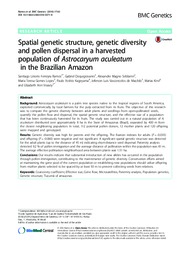Spatial genetic structure, genetic diversity and pollen dispersal in a harvested population of Astrocaryum aculeatum in the Brazilian Amazon.
Spatial genetic structure, genetic diversity and pollen dispersal in a harvested population of Astrocaryum aculeatum in the Brazilian Amazon.
Author(s): FERREYRA RAMOS, S. L.; DEQUIGIOVANNI, G.; SEBBENN, A. M.; LOPES, M. T. G.; KAGEYAMA, P. Y.; MACEDO, J. L. V. de; KIRST, M.; VEASEY, E. A.
Summary: Astrocaryum aculeatum is a palm tree species native to the tropical regions of South America, exploited commercially by local farmers for the pulp extracted from its fruits. The objective of this research was to compare the genetic diversity between adult plants and seedlings from open-pollinated seeds, quantify the pollen flow and dispersal, the spatial gene tic structure, and the effective size of a population that has been continuously harvested for its fruits. The study was carried out in a natural population of A. aculeatum distributed over approximately 8 ha in the State of Amazonas (Brazil), separated by 400 m from the closest neighboring population. In total, 112 potential pollen donors, 12 mother plants and 120 offspring were mapped and genotyped.
Publication year: 2016
Types of publication: Journal article
Unit: Embrapa Western Amazon
Observation
Some of Embrapa's publications are published as ePub files. To read them, use or download one of the following free software options to your computer or mobile device. Android: Google Play Books; IOS: iBooks; Windows and Linux: Calibre.
Access other publications
Access the Agricultural Research Database (BDPA) to consult Embrapa's full library collection and records.
Visit Embrapa Bookstore to purchase books and other publications sold by Embrapa.

